Gemstone Polishing Wheels: Types and Applications
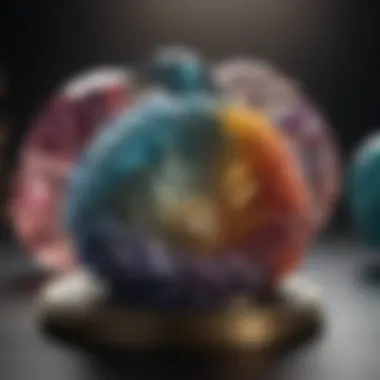
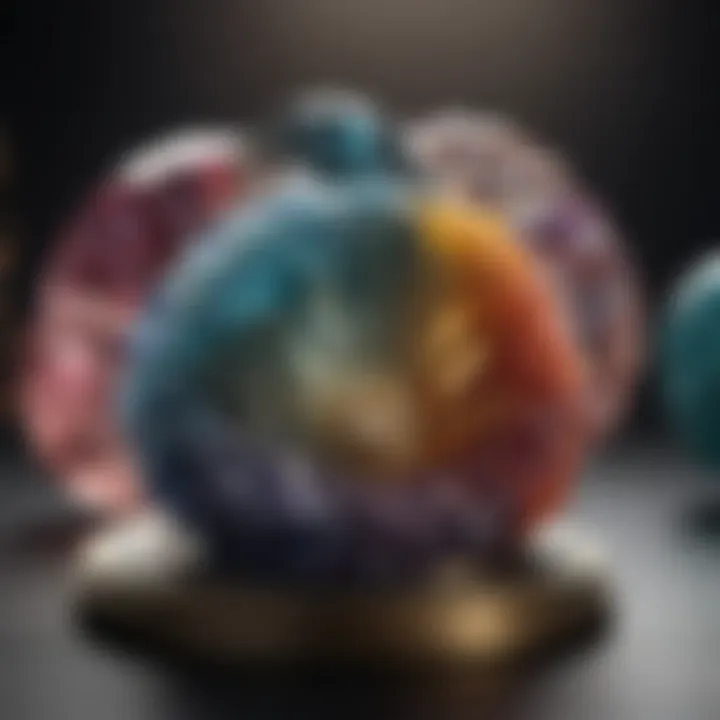
Intro
Gemstone polishing wheels play a pivotal role in the art of gemology, transforming raw stones into radiant treasures. This section serves as the gateway into understanding not just the tools themselves, but their practical applications, materials, and types that vastly influence the outcome of polishing. From amateur jewelry makers to seasoned professionals, everyone can appreciate the nuance of achieving a superior polish on their gems.
As we journey through this guide, we will illuminate the key aspects of gemstone polishing wheels, emphasizing their significance in enhancing both the beauty and value of gemstones.
Gemstone Overview
Definition and Characteristics
In the realm of gemology, a gemstone is typically defined as a precious or semi-precious mineral, which has been cut and polished for use in jewelry or ornamentation. They are known for their brilliance, clarity, and color — characteristics that captivate audiences around the world. Gemstones can vary significantly in hardness, luster, and other physical properties. For instance, diamonds boast an exceptional hardness rating of 10 on the Mohs scale, while softer stones like talc sit at a mere 1. This diversity in characteristics is what makes gemstones not only visually stunning but also technically challenging to work with.
Classification of Gemstones
Gemstones can be classified based on several criteria. The most common classifications include:
- Precious Gemstones: These are the natural gemstones that are considered the most valuable, including diamonds, rubies, sapphires, and emeralds.
- Semi-Precious Gemstones: While still beautiful, these stones are more abundant and less expensive compared to precious gems, including amethyst, garnet, and aquamarine.
- Organic Gemstones: Unlike traditional minerals, these are derived from biological processes, examples being pearls and amber.
The classification not only helps in understanding their market value but also guides gemologists and collectors in selecting suitable polishing methods.
Historical Significance
Ancient Uses and Cultural Importance
Throughout history, gemstones have held significant cultural value, often associated with healing properties, status, and power. The ancient Egyptians adorned themselves with lapis lazuli, believing it brought protection and wisdom. Similarly, in many cultures, certain stones were thought to harbor mystical abilities. The use of gemstones can be traced back to various civilizations, where they served as symbols of wealth and prestige. For jewelry designers and collectors today, this rich history infuses deeper meaning into the gems they choose.
Myths and Legends Surrounding Gemstones
Many gemstones are steeped in folklore and mythology, which can enhance their allure. For instance, the belief exists that amethysts can protect against drunkenness, while turquoise is said to bring good fortune and happiness. Such tales not only contribute to the mystique of the stones but also can influence modern trends in gemstone selection.
"The belief in the powers of gemstones stretches across time and cultures like an intricate tapestry of human imagination and desire."
Through these narratives, gemstone polishing wheels become more than just tools; they are instruments of historical and cultural significance that can unlock the full potential of these natural masterpieces.
Preamble to Gemstone Polishing
The journey of a gemstone from a rough rock to a stunning piece of jewelry relies heavily on the polishing process. Polishing is not just a superficial task; it’s fundamental in unveiling the true beauty of gemstones. When you think about it, a raw gemstone may have the potential for brilliance, but without the right polishing techniques, it remains cloaked in dullness. In this section, we’re going to delve into the intricacies of gemstone polishing, focusing on the processes and reasoning behind it.
To fully appreciate gemstones, one must understand how the polishing process evolves from ancient methods to modern techniques. Over the centuries, gem polishing has transformed, enriching the trade’s practices and leading to shiny stones that catch the eye. These polishing wheels play a critical role, shaping how jewelers and enthusiasts treat gemstones.
One of the key benefits of mastering polishing techniques is the increase in a gemstone's market value. Well-polished stones glimmer, enticing collectors and buyers alike. Whoever holds the perfectly polished gem not only possesses a beautiful object but also a piece of financial investment.
The Evolution of Gemstone Polishing Techniques
Back in the day, the techniques used for polishing gemstones were quite rudimentary. Picture a time when artisans relied on simple tools, perhaps a hard stone or some sand. Techniques like these were labor-intensive and demanded not just skill but a great deal of patience. As time rolled on, tools evolved from simple devices to more advanced equipment, significantly streamlining the polishing procedure.
Today, we see a mix of tradition and innovation. The advent of machinery has allowed for speedier, more consistent polishing, yet the handcrafted touch remains highly valued. Jewelers often find that blending techniques can yield outstanding results. For instance, while using a machine for initial shaping, finishing by hand often brings out complexities that machines might overlook.
In modern gemology, polishing wheels have become the go-to instruments. With various materials available, each offers its unique advantages. From diamond wheels that cut like a knife to softer felt wheels for final touches, the choices can boggle the mind. It’s fascinating how much the craft has shifted, isn’t it?
The Role of Polishing in Gemstone Enhancement
The final appearance of a gemstone is heavily influenced by how it has been polished. Polishing brings out the color, clarity, and luster, essential elements that define a gem's appeal. It's not just about making a stone shiny; it’s about enhancing its inherent beauty. A well-polished gemstone can exhibit brightness and depth that an unpolished one lacks, creating a visual dialogue that invites admiration.
Moreover, different types of gemstones require unique polishing techniques. Harder stones like diamonds need diamond-coated wheels, while softer gems like opals must be treated delicately to avoid damage. Knowing which tools to use for specific gemstones is a skill that every jeweler must master to achieve impeccable results. This understanding is what separates the novice from the experienced.
To sum it up, the evolution and role of polishing reveal much about the art and science behind gemstone enhancement. It's essential knowledge for anyone keen on enjoying the beauty of gemstones and exploring the secrets they hold.
Understanding Polishing Wheels
Understanding polishing wheels is a core element in the gemstone polishing process. These wheels serve not just as tools, but as pivotal components that dictate the finish and quality of gemstones. The right polishing wheel can make the difference between a lackluster stone and one that dazzles with brilliance.
While newcomers may sometimes overlook this aspect, seasoned artisans recognize the subtlety and skill involved in selecting and using polishing wheels. Each wheel is designed with a specific purpose, compatible with various gemstone types, and contributes to achieving the desired aesthetic.
Definition and Purpose of Polishing Wheels
Polishing wheels are circular tools used to refine the surface of gemstones during the final stages of the polishing process. Simply put, they are used to bring out the shine and luster of the stone. Think of them as the finishing touches in a painter's masterpiece; without them, a beautiful work is left incomplete.
The main purpose of these wheels is to provide a uniform finish by removing minor scratches and surface imperfections from the gemstone. The composition of these wheels can vary significantly, depending on the type of finish required. For example, diamond polishing wheels are renowned for their aggressive polishing capabilities, ideal for hard stones, while softer wheels like felt are perfect for achieving a high-gloss finish on softer gems.
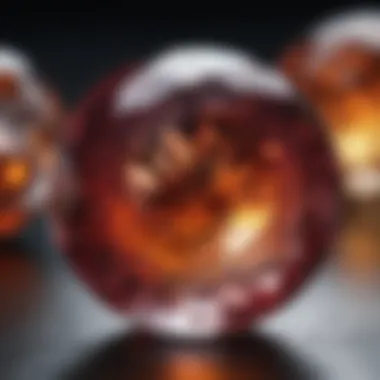
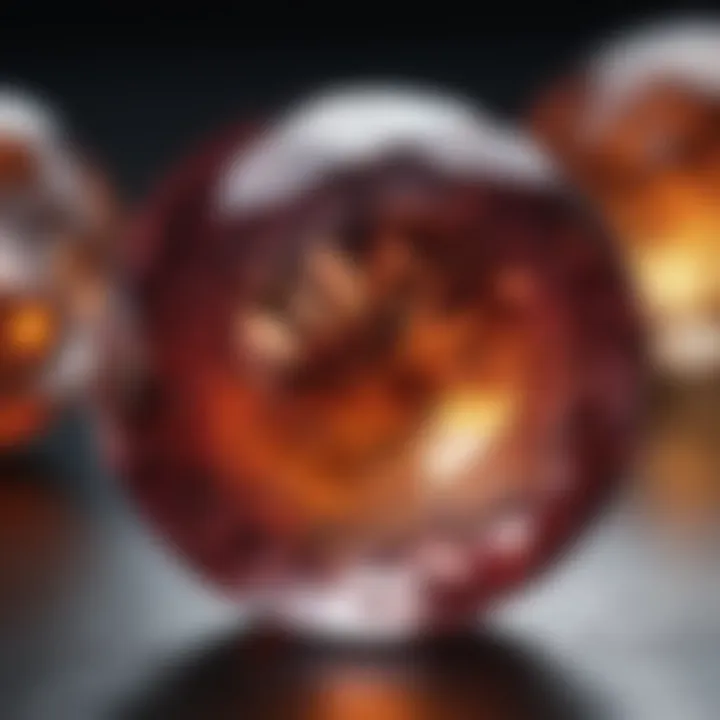
Moreover, polishing wheels are tailored to enhance the aesthetic appeal of different gemstones. Using the proper wheel not only improves the visual qualities of the stone but also ensures its durability and longevity. In essence, the right polishing wheel can transform an ordinary gem into an extraordinary one.
Key Components of Polishing Wheels
When delving into the specifics, several key components define the functionality and effectiveness of polishing wheels. Here are a few important factors:
- Material: The most critical component; polishing wheels can be made from a variety of materials, including diamond, ceramic, and felt. Each material serves a distinct purpose, affecting polish speed and surface finish.
- Grain Size: This refers to the size of the abrasive particles embedded within the wheel. Finer grains are used for a smoother finish, while coarser grains are ideal for more significant material removal.
- Thickness: The thickness of the wheel can influence its durability and the amount of pressure you can apply during use. Thinner wheels typically remove material more aggressively.
- Bond Type: The bond secures the abrasive particles and dictates the lifespan of the wheel. Different bond types offer varying degrees of flexibility and rigidity, affecting how the wheel performs under pressure.
- Diameter: The diameter can influence speed and ease of use, especially on larger gemstones. Larger wheels can cover more surface area but may require more control.
Understanding these components helps gem enthusiasts and professionals alike tailor their polishing processes, ensuring that the results are not just satisfactory but exceptional.
Types of Gemstone Polishing Wheels
Gemstone polishing wheels play a crucial role in the art of gem enhancement. Their varied types cater to different processes and results. Choosing the correct wheel can make all the difference between a dull stone and a sparkling gem. Let’s unpack the primary kinds of polishing wheels available and their specific benefits.
Diamond Polishing Wheels
Diamond polishing wheels are quite popular and for good reason. These wheels imbued with diamond grit can cut through hard materials like quartz or sapphires, transforming rough stones into polished wonders. The key here is the diamond's hardness; it slices and refines more effectively than most other materials.
Benefits of Diamond Polishing Wheels:
- Efficient Cutting: With their sharp, abrasive surface, they can grind away at rough edges in a fraction of the time required by other wheels.
- Versatility: They can be used on various materials beyond gemstones, making them a favorite among jewelers and lapidaries.
- Longevity: Due to the durable nature of diamond, these wheels tend to have a longer lifespan than their counterparts.
However, choosing diamond wheels means also considering their grit levels. Fine or coarse grits serve different purposes—finishing versus basic shaping. Knowing how to pair the grit with the gemstone type is essential.
Ceramic and Resin Wheels
Ceramic and resin wheels strike a balance between effectiveness and gentleness. Made from a mixture of ceramic particles and resin, these wheels are particularly suited for softer gemstones. They don’t strip away material too aggressively, preserving the shape and integrity of the stone.
Key Advantages of Ceramic and Resin Wheels:
- Controlled Polishing: They deliver a more even finish, minimizing the risk of over-polishing.
- Heat Management: These wheels generate less heat, thus reducing the chance of damaging heat-sensitive gems.
- Easy to Replace: While still offering durability, these wheels are often more economical than diamond wheels, making them accessible for hobbyists and professionals alike.
Ceramic wheels usually come in a variety of shapes and sizes, allowing for more intricate polishing work. Thus, they are favored in detailed applications where precision is key.
Felt and Cloth Wheels
For finishing touches, felt and cloth wheels are often employed. These wheels are not about the heavy lifting; instead, they shine and polish stones after they have been shaped. They create that eye-catching luster, ensuring the gemstones stand out attractively in any setting.
Benefits of Felt and Cloth Wheels Include:
- Polishing Without Aggression: They are soft enough to avoid scratching the surface while effectively smoothing out any marks.
- Accessory for Compounds: Often, these wheels work best when combined with polishing compounds that enhance the final finish.
- Versatility in Use: Beyond gemstones, these are useful in various other applications, such as metal polishing and wood finishing.
In using felt and cloth, practitioners need to ensure the wheel is kept clean to avoid transferring any unwanted residues onto the gemstones.
"The right choice of polishing wheel not only affects the efficiency but also the quality of the finish. Know the kind of gemstone you are working with to make the best selection."
In summary, understanding the types of gemstone polishing wheels is vital. Each type serves distinct purposes and caters to various gemstones. By choosing wisely, enthusiasts and professionals can achieve sublime results in their polishing endeavors.
Selecting the Right Polishing Wheel
Choosing the correct polishing wheel is more than just a good idea; it’s the cornerstone of achieving a polished gemstone that sparkles and shines. Getting this element right can change the whole outcome of your project. The appropriate wheel not only affects the efficiency of the polishing process but also enhances the quality of the final product. By understanding certain factors about polishing wheels, you can navigate through selections to find what suits your needs, whether you are a gem enthusiast or a professional lapidary.
Factors to Consider
Material of the Wheel
When it comes to polishing wheels, the material plays a pivotal role in the effectiveness of the polishing process. The most common materials include diamond, ceramic, resin, and felt. Each has unique characteristics making them more suitable for specific applications.
- Diamond Wheels: These are popular due to their hardness; they are able to tackle much tougher stones. Their unique feature is the diamond particles embedded in the wheel’s surface, making them an excellent choice for achieving precision on various gemstone types. However, they can be costly, so they are mainly used by those who know they will get a lot of use out of them.
- Ceramic Wheels: They tend to be more affordable, making them a common choice among amateurs. Their main advantage lies in their uniform structure, which provides a consistent finish. On the flip side, they might not hold up as well on tougher materials compared to diamond wheels.
The material's selection directly impacts both the performance and cost-effectiveness of your polishing projects in this article.
Application and Gem Type
Not all gemstones are created equal, and their characteristics influence the wheel selected for polishing. Each type of gem requires a specific approach. For example, softer stones like opal can be polished effectively with a resin wheel, whereas harder stones like sapphire need diamond wheels for an effective finish.
- Soft Gemstones: They often benefit from felt or resin wheels, which help to avoid scratches on the surface during polishing due to their gentle finish.
- Hard Gemstones: These stones require a higher abrasive type of wheel, usually diamond, to ensure a satisfactory finish and quality enhancement.
Understanding the application and gem type will help refine your choices down to the most relevant options for your polishing endeavors throughout this detailed article.


Desired Finish Quality
The quality of the final polish is very important in gemstone polishing. Factors like gloss level, smoothness, and overall appearance play into what the desired finish should look like. Higher quality finishes require a more meticulous approach—think of it like the icing on a cake, where it can truly make or break the look.
- High-Gloss Finish: Achieved using fine-grit wheels, this finish is sought after in jewelry making. It requires careful selection of polishing wheels with specific materials designed for fine details.
- Matte Finish: On the contrary, if a muted appearance is desired, coarser wheels will suffice. These can often be ceramic or even some felt options.
The desired finish quality shouldn't just be an afterthought but a driving factor behind your selection process, ensuring that the polished stones meet or exceed expectations.
Common Brands and Offerings
When it comes to buying polishing wheels, it pays to remember that not all brands are created equal. A few reputable brands are well-known in the industry, offering consistent quality and a wide range of products. Brands such as Flexovit and 3M provide reliable polishing wheels catering to various types of gemstones and finishes. Their offerings cover everything from diamond wheels to ceramic options, ensuring that there's something for every need.
Selecting the right wheel should be an informed decision, taking all these factors into consideration. Understanding the materials, applications, and desired finishes ultimately sets the stage for successful gemstone polishing.
Using Polishing Wheels Effectively
Understanding how to use polishing wheels effectively is crucial in the art of gemstone polishing. This section zeroes in on the elements that define successful polishing outcomes. The choice of wheel, the preparation of the gemstone, and the techniques employed during the polishing process can make or break the visual appeal and overall finish of the gem. Proper use not only enhances the gemstone’s brilliance but helps in maintaining the longevity of the polishing equipment.
Preparing the Gemstone for Polishing
Before diving into the polishing itself, it is essential to prepare the gemstone meticulously. This stage is like setting the stage for a grand performance. Start by cleaning the gemstone thoroughly. Any dirt or residue can lead to scratches or an uneven finish. A simple wash with soap and water followed by a rinse often does the trick.
The next step is to examine the gemstone for any blemishes or cracks. If imperfections are present, it's wise to address those first. For instance, using lower grit wheels can help remove larger scratches while progressively increasing the grit of the wheel allows for a smoother finish.
- Thorough Cleaning: Remove all dirt with mild soap and lukewarm water.
- Inspection: Check for chips or fissures that might need attention.
- Selecting Grit Levels: Begin with a coarser grit to eliminate deeper marks, then move to finer grits.
Best Practices for Wheel Usage
Once the gemstone is prepped, attention must shift to the polishing wheels themselves. Proper usage can drastically affect the outcome. First and foremost, ensure the right wheel is matched with the type of gemstone being polished. Different gemstones respond distinctively to various wheel materials. For example, harder stones like sapphires benefit from diamond wheels, while softer stones are better suited to felt wheels.
Another critical consideration is wheel speed. Too fast, and you risk damaging the stone through overheating; too slow, and you may not remove enough material to achieve the desired shine. A speed around 1500 to 3000 RPM is generally ideal for most applications, but always assess the response of your particular gem.
Moreover, polish in a consistent manner. Ensure even pressure and motion to achieve uniform results. This is not a race; steady hands yield the best results. Don’t hesitate to let the wheel do the work instead of forcing the gemstone into it.
- Wheel Selection: Match the wheel to the gemstone type.
- Control Wheel Speed: Aim for a balanced RPM range.
- Maintain Even Pressure: Follow a steady polishing pattern to avoid inconsistencies.
"Properly using polishing wheels is like having the right tools in the toolbox; it can make all the difference in the world."
These practices can go a long way in achieving a polished gem that not only looks good but also showcases the stone's natural beauty. With these strategies and insights, one can confidently approach gemstone polishing, turning raw stones into dazzling pieces worthy of admiration.
Common Challenges in Gemstone Polishing
Polishing gemstones is an intricate art, but it's not without its speed bumps. The journey towards that perfect shine can often be fraught with difficulties, which makes understanding these challenges crucial for both novices and seasoned gem polishers. This section discusses two significant issues: the compatibility between wheels and gemstones, and the danger of overheating which often leads to damage. By tackling these common pitfalls, gem enthusiasts can greatly improve their polishing skills and outcomes.
Identifying Wheel and Gemstone Compatibility Issues
Finding the right polishing wheel for a particular gemstone isn't just a matter of grabbing what's available. It’s a bit like pairing a fine wine with the right meal. Different wheels are designed for specific materials, and using the wrong one can result in disappointing finishes or even irreparable damage. For instance, a diamond wheel might work wonders on harder stones like sapphires but could be too aggressive for softer opals, potentially leading to chipping.
Moreover, factors like grain size play a critical role in ensuring a suitable match. A coarse wheel may quickly strip away material, while finer wheels are better for achieving that coveted glass-like finish. To simplify things, consider the following guidelines:
- Hardness of the Gemstone: Identify the Mohs hardness scale rating of your gemstone to ensure the wheel can effectively polish it without causing harm.
- Material Makeup: Consider what the wheel is constructed from. Some may contain metal, others ceramic or diamond, each suited for different applications.
- Desired Finish: Decide whether you need a preliminary polish or a high-gloss finish. A mismatch here can lead to unnecessarily long and frustrating polishing sessions.
Making these considerations can save time and resources, making gemstone polishing a more rewarding experience.
Avoiding Overheating and Damage
Overheating is a formidable foe in the gemstone polishing world. Just like oil left on too high of heat can ruin a dish, a gemstone subjected to excessive heat can lose its integrity, discolor, or even crack. This underlines the importance of monitoring not just the speed of the polishing process, but also the pressure applied and the duration of contact with the wheel.
Here are a few strategies to help maintain a safe polishing temperature:
- Less Pressure: Apply moderate pressure rather than forcing the wheel against the stone, as too much pressure can lead to friction and heat.
- Cool Down: Allow the gem to cool down periodically during polishing. You can immerse it in water briefly or simply give it time to breathe.
- Use Water or Lubricants: Incorporating water or specialized polishing compounds can help dissipate heat while also providing a smoother finish.
"Gemstone polishing isn't just a process; it’s a dance between art and precision, where the slightest misstep can lead to catastrophe."
Focusing on preventing overheating is essential for a successful outcome. To summarize, identifying wheel and gemstone compatibility issues is just as important as avoiding overheating during polishing. By proactively addressing these challenges, gem hobbyists and professionals can significantly elevate their skills and the quality of their work.
Polishing Wheel Maintenance
Maintaining your polishing wheels is not just about keeping things tidy; it's about ensuring their efficiency and longevity. These wheels are the linchpin of the polishing process, playing a pivotal role in determining the quality of the gemstone finish. By looking after these tools, you set yourself up for success, avoiding unnecessary costs and frustration down the line.
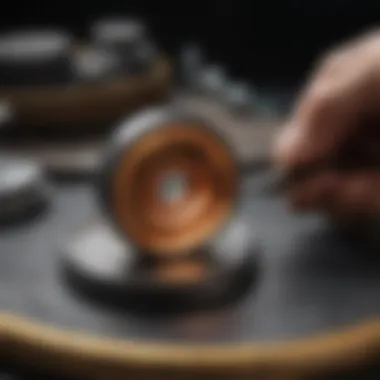
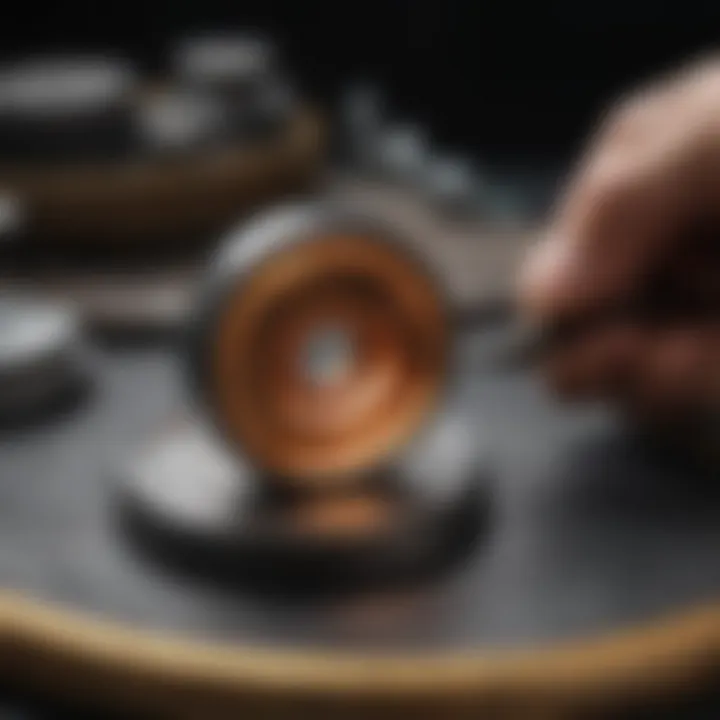
The benefits of regular maintenance can’t be overstated. A well-maintained wheel will promote a flawless polish, enhance consistency in your results, and extend the lifespan of your equipment. On the contrary, neglecting maintenance can lead to uneven polishing, premature wear, and even potential damage to your precious gemstones.
Cleaning and Storage Techniques
Keeping your polishing wheels clean is like keeping your tools sharp; it ensures they do their job effectively. After use, it's essential to remove any residue or compound that clings to the wheel. This not only maintains the wheel’s cutting and polishing efficiency but also prevents contamination that could affect the stones you're working on.
Some effective cleaning methods include:
- Use of Brushes: A gentle bristle brush can be handy to dislodge particles stuck in the wheel's surface. Be cautious not to damage the wheel.
- Compressed Air: This can be a lifesaver for getting into the nooks and crannies where dirt hides.
- Soaking in Cleaner: For thoroughly gummed-up wheels, a soak in a mild solvent specifically designed for polishing compounds can work wonders. Just ensure it's compatible with your wheel material.
After cleaning, storage is equally crucial. Ideally, wheels should be stored in a dust-free environment, away from direct sunlight and humidity. Using protective covers can help. Some users even create dedicated shelves or cases specifically for their wheels, treating them with the care they deserve.
Recognizing When to Replace Your Wheels
It’s important to be observant when it comes to determining the life of your polishing wheels. While there’s no strict rule for when a wheel should be replaced, certain signs can indicate that it’s time to say goodbye.
- Visual Deterioration: Check for any cracks, chips, or significant wear on the surface. If it looks like it’s seen better days, it probably has.
- Inefficiency: If you find that your wheels are no longer giving you the desired finish, even after cleaning, they might be past their prime.
- Heat Generation: Overheating can be a sign of impending malfunction. If your wheels are getting warm when in use, it’s time for an assessment.
Moreover, keeping a regular maintenance log can help in tracking your wheels' performance and lifespan. Documenting the usage and any issues encountered over time might offer clearer insights into when replacement is necessary. Each gemstone demands precision and attention, and ensuring the functional integrity of your wheels will go a long way in delivering exceptional results.
Advanced Techniques in Gemstone Polishing
When delving into the intricacies of gemstone polishing, advanced techniques emerge as the secret sauce to elevate the polish quality to an entirely new level. These methods are not just mere luxuries but vital skills that can significantly enhance the overall appearance and character of gemstones. They're about maximizing the potential of the stone while ensuring that the polishing process is as efficient as possible.
In this section, we’ll explore two pivotal advanced techniques: utilizing compound applications and the adoption of specialist tools and equipment. These approaches require a bit of finesse and experience but can yield remarkable results that are well worth the effort.
Utilizing Compound Applications
Compound applications play a significant role in gemstone polishing, serving as an essential aspect of achieving that perfect gleam. The use of polishing compounds introduces various levels of abrasiveness, which can be finely tuned based on the gemstone's hardness and desired finish. By selecting the right type of compound, jewelers can remove micro-scratches and enhance the stone’s color and clarity.
Some common polishing compounds include:
- Diamond Paste: Known for its sharpness, diamond paste is particularly effective on hard stones.
- Cobalt: Great for softer materials, cobalt compounds can help achieve that high-gloss finish without damaging the surface.
- Aluminum Oxide: Often used as a finishing compound, it provides a smooth final touch to gemstones.
It’s critical to match the compound’s grit size to both the gemstone's hardness and the wheels being used; too coarse a compound can cause more harm than good, while too fine may not produce the desired results.
In practice, jewelers often start with a coarser compound to eradicate major imperfections. Following this, they progressively switch to finer compounds, smoothening the surface until it reaches the coveted high-polish status. Understanding the sequential use of compounds essentially unlocks the door to a glossier finish that can make ordinary stones look extraordinary.
Specialist Tools and Equipment
To further enhance polishing results, utilizing specialist tools and equipment is a game changer in gemology. While conventional polishing setups are adequate for many tasks, incorporating specialized gadgets can streamline the process and maximize efficiency.
The following tools are commonly found in a professional’s arsenal:
- Rotary Polishers: These are versatile tools that can be adjusted for speed and pressure, allowing for precise control during the polishing phase.
- Lapidary Machines: Specifically designed for stone shaping and polishing, these machines often feature multiple wheels, making them ideal for intricate work on gemstones.
- Ultrasonic Cleaners: Not strictly for polishing, ultrasonic cleaners ensure that stones are free from dirt or residues, which is vital when switching between compounds or when starting a new polishing job.
When working with any of these specialized tools, it’s crucial to understand their operation fully. This can prevent mistakes that could damage the stones or compromise the polishing process. Careful selection and application of both compounds and tools is essential for carving out beautiful and lasting pieces that speak volumes about craftsmanship.
Advanced techniques in gemstone polishing not only refine the aesthetic appeal of each stone but also contribute to the longevity of the piece. Embracing these methodologies can provide both enthusiasts and professionals with a greater understanding and appreciation of the intricate work behind polishing gemstones.
Epilogue
In wrapping up our exploration of gemstone polishing wheels, it’s crucial to understand the significance and multifaceted nature of this topic. This article has navigated through the various types of wheels, materials, and techniques that define the art of polishing gemstones. For enthusiasts and professionals alike, mastering this craft is not just about improving the surface appearance; it’s about enhancing the essence of the stone itself.
Polishing plays a pivotal role in gemstone treatment, as even the most exquisite gem can fall flat without the right finishing touches. An effective polishing process can accentuate a stone's colors, reveal hidden brilliance, and even influence its perceived value. By understanding the intricacies of polishing wheels, individuals can leverage this knowledge to achieve a level of quality that transforms their work from the ordinary to the extraordinary.
Moreover, selecting the appropriate wheel crafted for specific gemstone types or achieving a desired finish is paramount. Each polishing wheel offers unique characteristics that dictate not just the result but also the method of application. A sound decision-making process can lead to marked improvement in the final outcome.
As we look toward the future of gemstone polishing, technological advancements promise to reshape techniques and tools. Innovations could improve efficiency and precision, bringing new opportunities to professionals and hobbyists. This ongoing evolution underscores the importance of staying updated with industry trends and continuously honing skills.
Thus, it is clear that delving into the world of gemstone polishing wheels is an investment in both knowledge and craftsmanship. Understanding the fundamental concepts discussed here can set the stage for future endeavors and a deeper appreciation of the art of gemology.
Summary of Key Insights
Throughout this article, we’ve addressed essential components that define gemstone polishing wheels and their practical applications:
- Types of Polishing Wheels: Understanding various options, including diamond, ceramic, felt, and cloth wheels, is imperative for achieving desired results. Each type serves specific purposes and comes with distinct advantages.
- Selection Criteria: Factors such as wheel material, application, and the type of gemstone should guide the decision-making process when choosing a polishing wheel.
- Best Practices: Proper wheel usage and maintenance practices can improve durability and output.
- Advanced Techniques: Tools and compounds can enhance results, allowing for greater versatility in polishing efforts.
The Future of Gemstone Polishing
The landscape of gemstone polishing is on the brink of transformation, influenced by both technological advancements and evolving artistry in gemology. New tools and techniques are constantly being researched and developed. Here are a few anticipated trends:
- Automation: Precision machines could become prevalent, facilitating faster and more accurate polishing. This would allow artisans to focus more on creativity rather than labor-intensive processes.
- Eco-Friendly Materials: With heightened awareness of environmental issues, expect to see a shift toward more sustainable materials that may also offer unique polishing properties.
- Customization: As the demand for personalized gems rises, polishing methods may need to adapt to cater to intricate bespoke designs.
- Cross-Disciplinary Approaches: Collaboration between jewelers and engineers may result in innovative products and methods that enhance the quality and efficiency of gemstone polishing.
In summary, the journey through gemstone polishing wheels uncovers not just techniques but a broader narrative about precision, creativity, and sustainability in the field. As this industry continues to evolve, staying informed will be vital for those keen on mastering the art.







